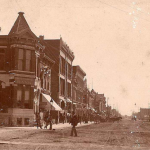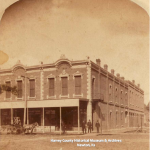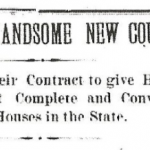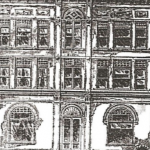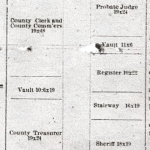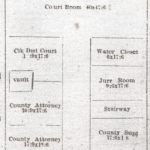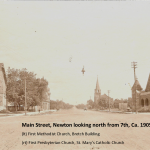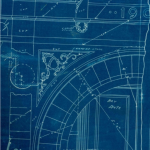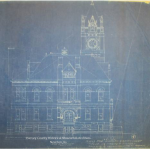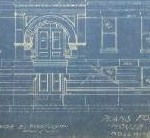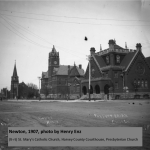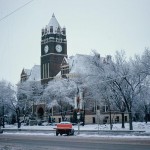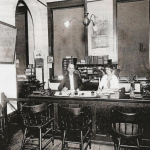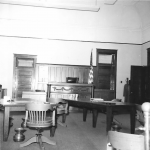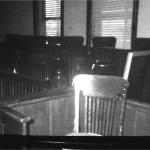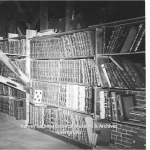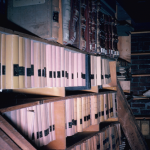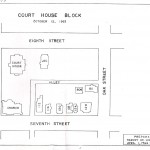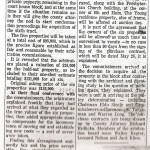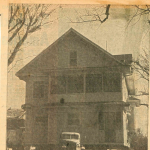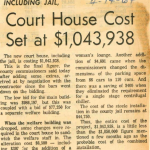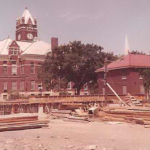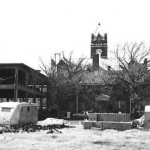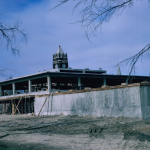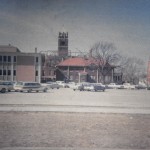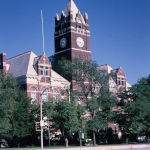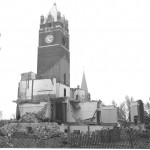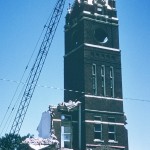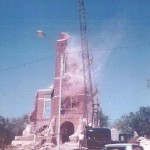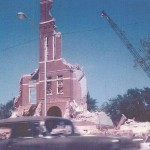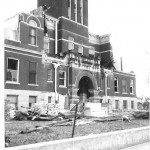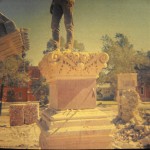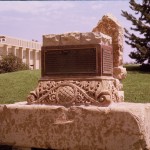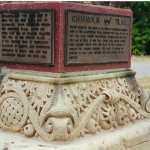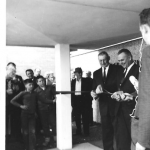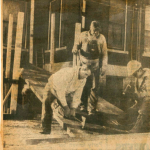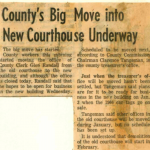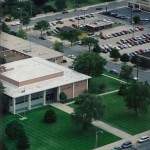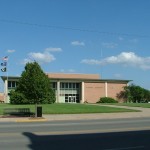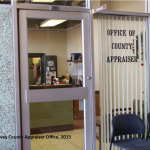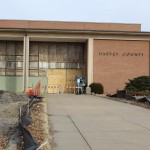Click on first image to scroll through slideshow. Special thanks to the Kansas Humanities Council for underwriting the collection of the oral histories included in this exhibit.
- The “Johnson Building,” located at Main & Broadway, was designated as the location for the County Offices in July of 1872. By January of 1873, the offices had moved to 1st National Bank building (pictured) at 526 N. Main. This building was built by B.C. Arnold. In 1875 the courthouse and offices were moved to the second floor of the Hamill Building at 513 N. Main, and remained there until 1880.
- The Masonic Building, 700 N. Main, housed the courthouse from 1880-1888 and 1897-1906. Photo ca. 1880
- In the fall of 1888, the Bretch Building was completed and the courthouse was moved there. The Bretch Building was located across Main from the current courthouse in what is now the parking lot for the First United Methodist Church.
- Fall 1888 newspaper article trumpeting completion of Bretch Building to house courthouse.
- Drawing of front of Bretch Building. The architect was William L. Ross.
- Layout of first floor of Bretch Building.
- Layout of second floor of Bretch Building.
- In 1896, the Masonic Building was once again the location for the county courthouse and offices. This postcard from 1897 shows large American flags, which were drawn into the photo, a typical addition for the time.
- In 1904, a site for a future courthouse had been purchased on the same block as the jail. This 1905 photo shows the courthouse block (before construction) looking north from 7th. The 1st UMC and Bretch Building are on left, with First Presbyterian and St. Mary Catholic on the right. At the time, Harvey County was the only county in south-central Kansas without a dedicated courthouse. J.S. Henderson, in his June 9, 1906 letter to the editor of the “Evening Kansas Republican” noted: “The present building used as a courthouse [Masonic Building] is undesirable, inconvenient, insecure, small and does not furnish the convenience or the proper accommodations for the performance of the business of the county. “The jury rooms were too small and they were ‘a sweat-box in summer and a refrigerator in winter’.” The vaults “which should be the Gibraltar of the courthouse” were small, dark and not secured. Finally, he pointed out that the county needed “a building to which each and every individual of the county could point with pride and say, ‘our courthouse’.”
- Blueprints detailing entrance of 1906 building.
- Blueprints of 1906 building.
- Blueprints of 1906 building.
- The “new” courthouse being constructed in 1906, with the county jail in the background.
- The architect for the project was J.C. Holland, who was also the architect for the Marion County Courthouse. The Romanesque structure featured brick trimmed with Bedford stone, and interior marble wainscoting. Image is a postcard of the courthouse.
- Postcard of courthouse and First Presbyterian Church.
- 1907 photo by Henry Enz, featuring (from left to right) St. Marys Catholic Church, Harvey County Courthouse and First Presbyterian Church. Looking northeast from the 600 block of Main.
- Winter, c. 1952, looking from southwest. Holiday decorations featured on lightposts. Photo by J. Stuart Birch
- Ruby Berry working in judges office with unidentified man, c. 1915.
- Courtroom, c. 1950s
- Jury seating in courtroom, c. 1950s
- Record storage in the Harvey County Courthouse, 1906-1966.
- Record storage in courthouse, 1906-1966
- Record storage in courthouse, 1906-1965
- Layout of courthouse block, 1963.
- First Presbyterian Church and the Wichita Presbytery accepts the county offer of $42,500 for the church building located in the courthouse block. The congregation retained rights to use the building until January 1, 1960. The commissioners made the offer earlier in the month after a 2-1 vote.
- The May 22, 1963 article details that five of the six houses/tracts have been purchased. The sixth owner was requesting a higher buyout, and the commission had the county attorney begin the process of condemning the property to obtain ownership.
- By May 24, 1963 (one day following the discussion of condemning the sixth property), the property owner had “capitulated and the deal was on.” The county took possession of the properties and the homes were auctioned to be moved or were demolished.
- Moving a house from the courthouse block prior to construction beginning in 1965.
- House on courthouse block prior to construction beginning in 1965.
- This April 14, 1964 article details cuts made to the project and the final cost anticipated.
- The project begins in 1964.
- November, 1964.
- Progessing . . .
- New courthouse on left. Old jail and old courthouse in the back.
- New building with exterior complete. 1906 building on the left.
- 1906 Courthouse in front of complete 1965 courthouse, prior to demolition of old building.
- Clock in 1906 building.
- Going down.
- Riding the bell down.
- Demolition in progress.
- More demolition.
- Nearly down.
- The bell
- Nothing left but rubble
- Main entrance of 1906 building showing pillars and bases.
- Entrance pillar base coming out.
- Entrance pillars used for historical markers on Highway 15 and at the Wellness Center.
- Pillar bases were given to the Harvey County Historical Society and used as part of historical markers on Highway 15 and at the Wellness Center.
- Clock in 1966 building, currently not functioning.
- Moving into the courthouse, 1966.
- Governor Avery presiding over the ribbon-cutting.
- Moving into the courthouse, 1966.
- Newspaper article highlighting the move into the new building, 1966.
- Moving into the courthouse, 1966
- Clockworks in the 1906 building.
- Clockworks in the 1906 building.
- Clockworks in the 1906 building.
- Aerial shot 1993.
- About 2008.
- March 2015 view of appraisers office.
- Renovations and improvements on current courthouse.
- Renovation and improvement projects, 2015.


